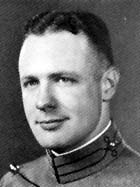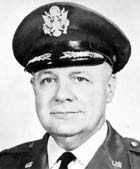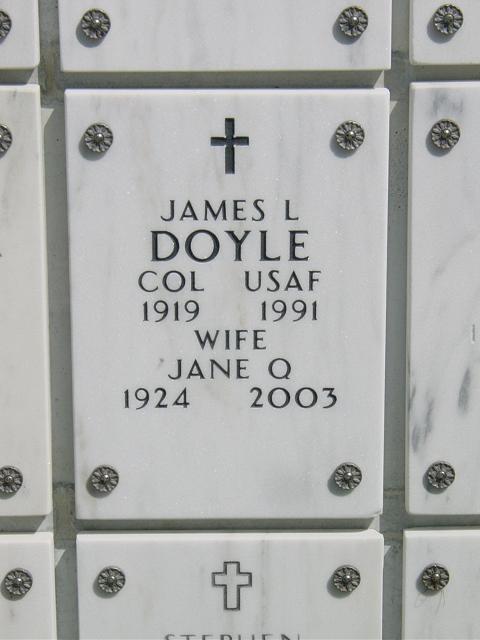James Leslie Doyle
No. 13277 • 15 March 1919 – 7 November 1991
Died in Clearwater, Florida, aged 72 years
Interment: Arlington National Cemetery, Arlington, Virginia
DURING OUR SHORT COURSE IN MILITARY ART, we were taught that two German generals in World War I were so closely in tune with each other’s thoughts that their initials were written as one. Almost as close were James “Pappy” Doyle and Jack Lovett. Their escapades as cadets are written in the history of West Point and are still part of cadet lore. In retirement they lived not far apart in Florida. Death came for them in the same year.
Pappy Doyle’s life is a microcosm of classic America in the last century. Pappy’s grandfather, John H. Doyle, was born in Kentucky and fought in the Civil War alongside his father and brother. He homesteaded the land for their home in Missouri and there had eleven children. The youngest son, Sherman (Pappy’s father), picked up his family and moved to California when Pappy was about four. This was no easy trip in a car of that vintage. There were not even paved roads across the desert, nor were there the ubiquitous motels of our day. A tent was their home at night. Pappy graduated from high school in Oakland, the Dodd School in Berkeley, and then enlisted in the National Guard — a route which led to the Fort Scott West Point Prep School. In Company B of the 159th Infantry, Pappy was a member of the rifle team that defeated all other local teams. When he won an appointment to USMA, the local papers featured him as a former carrier of the Tribune and Cadet Major of the high school ROTC detachment.
Pappy’s cadet escapades are covered in detail in the article on JACK LOVETT. His combative nature won him his numerals in football as a guard, and he was on the goat football team. But his Area hours allowed him little time for later Corps squads, although he was in several clubs. He did not have to work hard in academics but sailed along in the middle third of the class. As mentioned in the later article, his life changed when Jack Lovett asked him to take his date through the receiving line at Graduation Hop, since Jack had been asked to take his sister through. By the time Jack ever found them to reclaim his date, Pappy’s heart belonged to Jane Quick and hers to him. They were married after graduation.
The air element of our class graduated with wings and went off to further training before battle. Pappy joined the 474th Fighter Group (P-38s), serving progressively as Flight Leader, Operations Officer, and Squadron Commander. He flew 93 missions and was awarded the Distinguished Flying Cross, 14 Air Medals, and the Croix de Guerre from both Belgium and France. But these bare statistics hide a fascinating tale.
Pappy started fighting four months before D-Day. His third kill was one that was to remain shrouded in mystery for many years. He shot down one of Germany’s most famous aces, Oberst Walter Oesau, on Oesau’s 150th mission. Oesau was one of Germany’s most decorated pilots. By the time he was shot down, he was credited with 123 victories, among them ten four-engined bombers. He had been awarded the Knight’s Cross, Oak Leaves to the Cross, and Swords to the Knight’s Cross. Johannes Steinhoff, with whom some of us were to serve in NATO, called Oesau the toughest fighter pilot in the Luftwaffe.
The mission was clouded in mystery for many years because it took place at such high altitude. Oesau’s falling plane was engaged by other aircraft at lower levels and they thought they had scored. But Oesau crashed near St. Vith, Belgium (some years later to draw many classmates into the Battle of the Bulge), and the German files show he was killed by an explosive shell into the cockpit area.
The bomber mission, protected by Pappy’s four planes, among others, was attacked by 28 Me-109s. Pappy dropped his tanks and prepared for combat. Suddenly, he checked his rear view mirror and saw a 109 behind him. He pulled his plane into the tightest possible turn, firing as he cane out behind the 109, and saw hits in the cockpit area. The German plane dropped from view, and Pappy did not know his own victory. Films from that flight were delayed in processing and came in mixed with many others. Pappy thought he had a “probable” but no importance was attached to the claim. It was not until 1983 that a magazine published the finding that Pappy had brought down one of Germany’s most famous aces.
Shortly after D-Day, Pappy volunteered to be Forward Air Controller for the French 2nd Armored Division and was in their ranks when they took Paris, one of the first Americans in that city. After V-E Day, he took command of the French Riviera Base. After returning home, he moved gradually into the Office of Special Investigation, the investigative branch of the Air Force. During the Korean War, he was chief of target selection for the Far East Air Force. Then OSI reclaimed him for most of the rest of his career. He retired with his DFC, Air Medal with 18 Oak Leaf Clusters, Bronze Star, and many commendation medals, plus the foreign decorations already mentioned.
In his business life, he became Executive Director of the Mechanical Contractors Association of Kentucky and later of the Electrical Contractors of Tampa, Florida. He retired from that work in 1975, fifteen years after retiring from the Air Force. Ties with France remained strong, and he became American President of the Franco-American Association of Normandy Airdromes of the Ninth U.S. Air Force. He was in many civic and veterans’ organizations and was president of the Association of Former OSI Special Agents. Pappy Doyle was stricken and died in Clearwater in November 1991, just as he and I were finishing Jack Lovett’s obituary. Their lives were so intertwined that it seems as though Fate had already decided that the two should leave us not far apart in time. Pappy was a very unconventional person but a superb fighter. His personality affected everyone with whom he came in contact. World War II embraced the most spectacular part of his career, but his service to the country and contributions to our security never ceased. We like to think that he and “The Mole” are once again sipping a few in Fiddler’s Green, just as they used to many years ago when they slipped out of barracks at night and frequented the Piccadilly Bar in New York.
He is survived by his wife and companion of so many years, Jane, and by three children: Patricia Jane Cooke, James L. Doyle, Jr., and Ruth Ellen Alexander. His grandson, William Doyle Alexander, carries forward the name Doyle, but the spirit of that innovative soldier and airman lives on in many other places. RIP, brave pilot.
DOYLE, JAMES L
- COL US AIR FORCE
- VETERAN SERVICE DATES: 09/01/1937 – 10/26/1960
- DATE OF BIRTH: 03/15/1919
- DATE OF DEATH: 11/07/1991
- DATE OF INTERMENT: 05/15/1992
- BURIED AT: SECTION 3-O ROW 8 SITE 2
ARLINGTON NATIONAL CEMETERY
DOYLE, JANE Q
- DATE OF BIRTH: 08/31/1924
- DATE OF DEATH: 08/02/2003
- DATE OF INTERMENT: 05/14/2004
- BURIED AT: SECTION 3-O ROW 8 SITE 2
ARLINGTON NATIONAL CEMETERY - WIFE OF DOYLE, JAMES L COL US AIR FORCE
Michael Robert Patterson was born in Arlington and is the son of a former officer of the US Army. So it was no wonder that sooner or later his interests drew him to American history and especially to American military history. Many of his articles can be found on renowned portals like the New York Times, Washingtonpost or Wikipedia.
Reviewed by: Michael Howard



